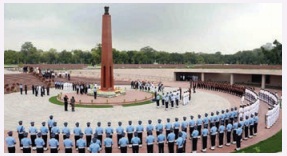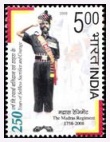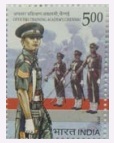Chapter 6 | Civics | 8th Social Science - Security Forces in India can be divided into | 8th Social Science : Civics : Chapter 6 : Defence & Foreign Policy
Chapter: 8th Social Science : Civics : Chapter 6 : Defence & Foreign Policy
Security Forces in India can be divided into
Indian Defence Services
The President of India being the
head of the State occupies the highest position in our defence organisation. He
is the supreme commander of the Armed forces in India.
Security Forces in India can be
divided into
Indian Armed Forces – They are primary forces
consist of country’s Army, Navy, Air Force and Coast guard. They serve under
the Ministry of Defence.
Paramilitary Forces – They are Assam Rifles
and Special Frontier Force.
Central Armed Police Forces – They are BSF, CRPF, ITBP, CISF and SSB. They serve under the authority of
Ministry of Home Affairs. CAPF work along with both Army and Police in
different roles assigned to them.
1. Indian Armed Forces
Army
The Indian Army is the land-based
branch and it the largest volunteer army in the world. It is commanded by the
Chief of Army Staff (COAS), who is a four-star general. The primary mission of
the Indian Army is to ensure national security, national unity, defending the
nation from external aggression, internal threats and maintaining peace and
security within its borders. It conducts humanitarian rescue operations during
natural disaster and calamities. The Indian Army has a regimental system. It is
operationally and geographically divided into seven commands.
The National War
Memorial is a monument built by the Government of India to honour the Indian
Armed Forces. The memorial is spread over 40 acres of land and is built around
the existing chhatri (canopy) near India Gate, New Delhi. The names of armed
forces personnel martyred during the conflicts are inscribed on the memorial
walls.

Navy
The primary objective of the navy is
to safeguard the nation's maritime borders, and in conjunction with other Armed
Forces of the union, act to deter or defeat any threats or aggression against
the territory, people or maritime interests of India. The Chief of Naval Staff,
a four-star Admiral, commands the navy. It has three Naval Commands.
Air Force
The Indian Air Force is the air arm
of the Indian armed forces. Its primary mission is to secure Indian airspace
and to conduct aerial warfare during armed conflict. The Chief of Air Staff, an
air chief marshal, is a four-star officer and is responsible for the bulk of
operational command of the Air Force. It has seven commands.

Indian Coast Guard (ICG)
The Indian Coast Guard was
established in 1978 by the Coast Guard Act, 1978 of the Parliament of India as
an independent Armed force of India. It operates under the Ministry of Defence.
The Coast Guard works in close cooperation with the Indian Navy, the Department
of Fisheries, the Department of Revenue (Customs) and the Central and State
police forces.
2. Paramilitary Defence Forces
The Forces which help in maintaining internal security, protecting the coastline and assisting the army are known as “Paramilitary Forces”. The responsibility is the security of important places like Railway stations, Oil fields and refineries, water reservoirs lines. They also participate in the management of natural or man- made disasters.
Field Marshal – is a Five Star
General officer rank and the highest attainable rank in the Indian Army.

Arjan Singh was the first and the only offi ce of the Indian Air Force to be promoted to Five Star Rank as Marshal.

Sam Manekshaw was the first Field Marshal of India and the second Field Marshal was K. M. Cariappa.

The Madras Regiment is
one of the oldest infantry regiment of the Indian Army, originating in the year
1758. The Regimental Centre is at wellington, Udhagamandalam, Tamil Nadu.

In 1962, after the Sino-Indian War, the need to expand the number of officers was felt. Two Officers Training Schools (OTS) were established in Pune and Chennai to train officers for Emergency Commission into the Army. On 1st January 1988, the school was renamed as the Officers Training Academy (OTA).
During peace time, the paramilitary forces
also have the responsibility of protecting the international borders.
a) Assam Rifles (AR)
b) Special Frontier Force (SFF)
Assam Rifles (AR)
The Assam Rifles came into being in
1835 which was established by the British in the Assam region, as a militia
called the ‘Cachar Levy’. There are currently 46 battalions of Assam Rifles. It
is under the Ministry of Home Affairs (MHA).
Special Frontier Force (SFF)
The Special Frontier Force (SFF) is
a paramilitary special force of India created in 1962. This force was put under
the direct supervision of the Intelligence Bureau, and later, under the
Research and Analysis Wing, India's external intelligence agency.
3. Central Armed Police Forces
(CAPF)
Following five forces which come
under Ministry of Home Affairs were earlier considered paramilitary forces, but
from March’ 2011, They have been reclassifled as Central Armed Police Forces
(CAPF) to avoid confusion.
In 1025 AD (CE),
Rajendra Chola I, the Chola king from Tamil Nadu launched naval on the
city-state of expedition Srivijaya in maritime Southeast Asia, and conquered
Kadaram (modern Kedah). Rajendra's overseas expedition against Srivijaya was a
unique event in India's history.

i.
Central Reserve Police Force (CRPF)
ii.
Indo-Tibetan Border Police (ITBP)
iii.
Border Security Force (BSF)
iv.Central
Industrial Security Force (CISF)
v. Special Service Bureau (SSB)
Central Reserve Police Force
(CRPF)
The mission of Central Reserve
Police force shall be to enable the government to maintain Rule of law, public
order and internal security effectively and efficiently, to preserve national
integrity and promote social harmony and development by upholding supremacy of
the Constitution.
The Rapid Action Force is a
specialised wing of the CRPF (Central Reserve Police Force) to deal with riot,
crowd control, rescue and relief operations, and related unrest situations.
Indo-Tibetan Border Police
(ITBP)
It is a border guarding police
force. This force is specialized in high altitude operations. It is deployed
for border guarding duties from Ladakh to Arunachal Pradesh (India – China
border).
Border Security Force (BSF)
The border security force is a
Border Guarding Force of India. BSF is charged with guarding India's land
border during peace time and preventing transnational crimes.
National Cadet Corps (NCC)
National Cadet Corps
is a Tri-Services Organization, comprising the Army, Navy and Air Force,
engaged in grooming the youth of the country into disciplined and patriotic
citizens. The National Cadet Corps in India is a voluntary organization which
recruits cadets from high schools, colleges and universities all over India.
The Cadets are given basic military training in small arms and parades.
Central Industrial Security
Force (CISF)
The Central Industrial Security
Force was set up under an Act of the Parliament of India on 10th March 1969.
Its duties are guarding sensitive governmental buildings, the Delhi Metro, and
providing airport security.
Sashastra Seema Bal/ Special
Service Bureau (SSB)
Sashastra Seema Bal (SSB), in
English the Armed Border Force is the border guardening force for Nepal and
Bhutan border.
Home Guard
The Indian Home Guard is a voluntary
force, tasked as an auxiliary to the Indian Police.
15th January - Army
Day
1st February - Coast
Guard Day
10th March - Central
Industrial Security Force Day
7th October - Rapid
Action Force Day
8th October - Air
Force Day
4th December - Navy
Day
7th December - Armed
Forces Flag Day
Home Guards are recruited from
various cross sections of the civil society such as professionals, college
students, agricultural and industrial workers, etc. who give their spare time
for betterment of the community. All citizens of India, in the age group of
18–50, are eligible. Normal tenure of membership in Home Guards is three to
five years.
To protect and guard our nation, our
armed forces are always kept ready. Youth should come forward to service and
save the nation by joining the armed forces. Recruitment to the Defence
services is open to all Indians. It is the duty of every citizen to have an
opportunity to serve the country.
Related Topics